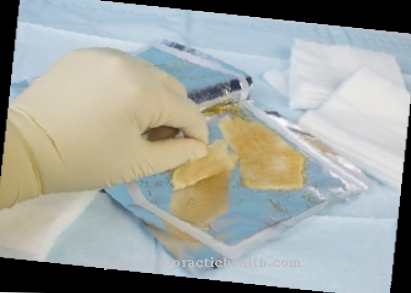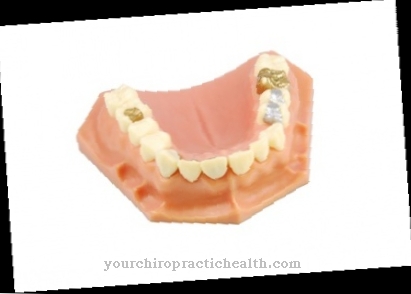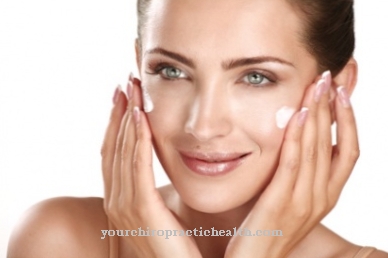Bath additives are added to the water in full and hip baths. They can have a stimulating, muscle relaxing, relaxing or nourishing effect.
What are bath additives?

Many people not only take a bath to cleanse, but also lie in the bathtub to relax. Bathing in warm water does not only serve to reduce stress. Balneotherapy makes use of the therapeutic effects of baths and the active ingredients they contain.
The most original form of this bath therapy is bathing in warm salt or medicinal water. Often, however, bath additives are also added to the bath water to support the effect of the water and the heat. Bath additives can be added to sitting or full baths. Sitz baths are mainly used for diseases of the anal and genital areas.
A distinction can be made between cold, rising and warm hip baths. The potassium permanganate hip bath is also known. The bath additive potassium permanganate is mainly used in the treatment of diaper rash.
Shapes, types & types
There are many different bath products. Bath salts are a classic. It is a granular bath additive made up of inorganic salts such as borax, sodium chloride or sodium phosphate. Bath salt in the form of bath tablets also contains binding agents such as talc or starch. Bath salt can also bubble. Citric acid or tartaric acid is added to it. Dyes and / or fragrances are often added to the bath salt. Thus, the bath water changes color and smells like spruce or rose, for example. When it comes to fragrances, a distinction can be made between perfumes and natural essential oils. Bath salts can also contain surfactants. Surfactants are substances that reduce the surface tension of a liquid. In bath salts, they act as washing-active substances or as solubilizers.
Bath oil is a liquid bath additive. Bath oils contain various oils such as almond oil, jojoba oil, grapeseed oil, apricot kernel oil or evening primrose oil. As a rule, bath oils are very economical. Just like bath salts, bath oils can also be mixed with aromatic oils or perfumes. In contrast to bath salts, bath oil does not completely dissolve in water.
Cream baths are also usually liquid bath additives. They do not contain as much oil as the bath oils and because of the added emulsifiers they mix better with the water. Different color and fragrance variations are also possible here.
So-called bath bombs are currently a trend. These are solid bath products that are usually available in the form of fist-sized balls. If these bath balls are put into the bath water, they dissolve and have a tingling effect due to the formation of small bubbles. In addition to salt, bath bombs contain bicarbonate. This is responsible for the effervescent effect.
Structure & functionality
Most bath products are added to the running bath water. Attention should be paid to the correct water temperature. Cold baths have a temperature between 15 and 18 degrees Celsius. Some bath products do not dissolve in cold water. More often, however, warm baths are taken. The bathing temperature here should be between 37 and 39 degrees Celsius. Baths with a rise in temperature should only be carried out under the supervision of qualified bath personnel.
Depending on the bath additive, the therapeutic bath should not last longer than fifteen minutes. The normal bathing time is between ten and fifteen minutes. For some indications, the bath should not last longer than two to three minutes.
Which bath additive should be chosen depends on the intention and the indication. A bath additive for relaxation should contain calming ingredients such as lavender or hops. Cold baths work well with essential oils made from eucalyptus or thyme. Oil or cream baths should be preferred for dry or sensitive skin. Bath bombs often have no health effect but are only used for bathing pleasure.
You can find your medication here
➔ Medicines for relaxation and nerve strengtheningMedical & health benefits
The medical and health benefits of the bath additive in question depend on the ingredients. Bathing relaxes the muscles through the warmth of the water. The blood circulation increases and the cardiac output increases with constant blood pressure values.
The main areas of application for bath additives are skin diseases, diseases of the rheumatic type such as fibromyalgia or rheumatoid arthritis, regeneration and psychosomatic diseases. Bath additives can also be helpful after sports injuries, colds or tension.
For skin diseases such as neurodermatitis, brine in particular has proven itself as a bath additive. While normal baths often remove moisture from the skin, the brine ensures that the water is stored in the outer horny layer of the skin. This preserves the skin's natural protective layer. In addition, essential minerals enter the body's circulation with the brine. These can stimulate the metabolism and help to activate the self-healing powers.
Bath additives with eucalyptus, thyme or mountain pine are suitable for cold baths. The essential oils of these plants have antiviral and antibacterial effects. They strengthen the immune system and can alleviate the body aches and pains that are common at the onset of a cold. A bath with a cold-relieving bath additive should only be taken at the first signs of a cold. If symptoms such as cough, runny nose or fever are already present, a hot bath with such a bath additive is not recommended. The burden on the sick body would be too high.
Bath additives with comfrey, arnica or rosemary are suitable for muscle and joint problems. Comfrey helps relieve musculoskeletal complaints. Arnica is both anti-inflammatory and analgesic. Rosemary improves blood circulation in the tissue and muscles and thus relieves tension. Bath additives with rosemary are also used to treat joint pain.

















.jpg)



.jpg)

.jpg)




